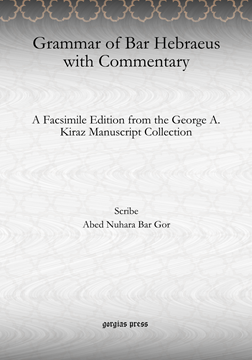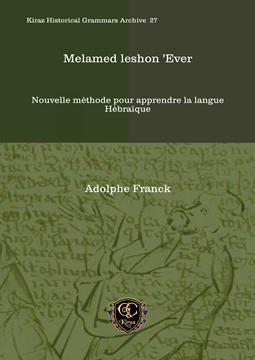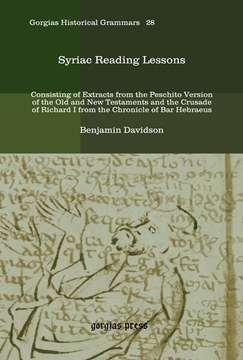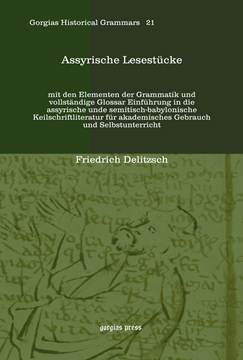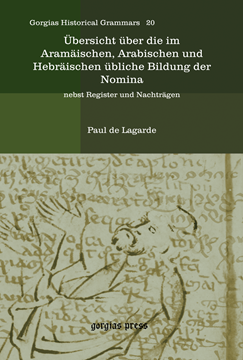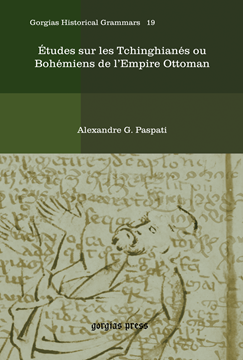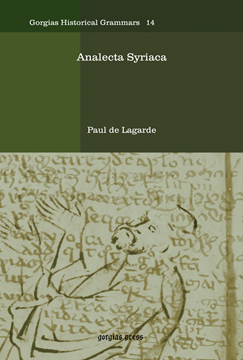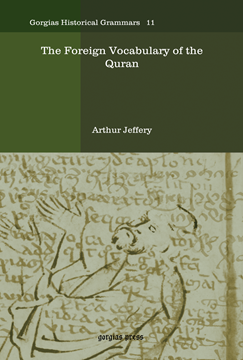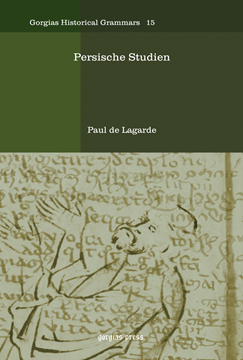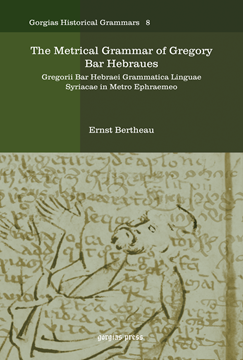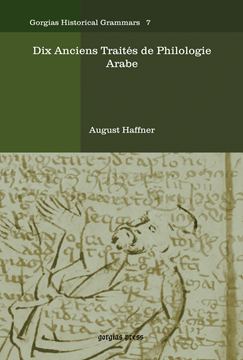Kiraz Historical Grammars Archive
Kiraz Historical Grammars Archive is a series intended to revive many of the classic grammars of ancient languages. These essential tools are becoming increasingly scarce, and yet they preserve many unparalleled insights into the languages they serve. Gorgias Press is pleased to bring them back into circulation.
Grammar of Bar Hebraeus with Commentary
A Facsimile Edition from the George A. Kiraz Manuscript Collection
Scribe Abed Nuhara Bar Gor
Series: Kiraz Historical Grammars Archive 38
ISBN: 978-1-61719-923-3
This volume is a facsimile edition of a handwritten manuscript of Gregory Bar Hebraeus's Grammar of the Syriac Language from the private collection of George A. Kiraz.
$77.00 (USD)
Grammatica Hebraica
By Elijah Levita; Translated by Sebastian Münster
Series: Kiraz Historical Grammars Archive 26
ISBN: 978-1-61143-295-4
Presented here is a complete Hebrew grammar compiled by the learned Venetian rabbi Elijah Levita.
$208.00 (USD)
Melamed leshon 'Ever
Nouvelle méthode pour apprendre la langue Hébraïque
Series: Kiraz Historical Grammars Archive 27
ISBN: 978-1-61143-301-2
This work introduces a new method of learning Hebrew: through conversation.
$171.00 (USD)
A Treatise on the Use of the Tenses in Hebrew
And Some Other Syntactical Questions
By S. R. Driver
Series: Kiraz Historical Grammars Archive 25
ISBN: 978-1-61143-286-2
This is an exhaustive work on the nature and force of the tenses in Hebrew, with a plenitude of examples, digressions and appendices on other topics.
$194.00 (USD)
The Semitic Alphabets
By Isaac Taylor
Series: Kiraz Historical Grammars Archive 36
ISBN: 978-1-61143-681-5
Isaac Taylor (1829-1901) is best known for his archaeological and philological works, especially his detailed study of the alphabets published in 1883. This book on the Semitic alphabets comprises the first volume of Taylor’s 1883 study. Taylor begins with a discussion on the invention of writing and the origin of the alphabet, then gives a discussion of three alphabetic families, what he calls the Phoenician alphabet, the Aramean alphabets (covering Palmyra, Hebrew, Syriac, Mongolian, and Arabic), and the south Semitic alphabets (covering Sabean and Ethiopic).
$176.00 (USD)
Elements of Syriac Grammar
By an Inductive Method
Series: Kiraz Historical Grammars Archive 30
ISBN: 978-1-61143-368-5
Robert D. Wilson’s grammar of Syriac includes many excerpts from Syriac literature to help explain grammatical concepts in real syntactical context.
$138.00 (USD)
A Letter on Syriac Orthography
by Mar Jacob, Bishop of Edessa and a Discourse by Gregory Bar Hebraeus on Syriac Accents
Edited and Translated by George Phillips
Series: Kiraz Historical Grammars Archive 29
ISBN: 978-1-61143-359-3
George Philipps presents the Syriac text and English translation for three ancient texts pertaining to Syriac grammar, orthography and pronunciation.
$123.00 (USD)
Syriac Reading Lessons
Consisting of Extracts from the Peschito Version of the Old and New Testaments and the Crusade of Richard I from the Chronicle of Bar Hebraeus
Series: Kiraz Historical Grammars Archive 28
ISBN: 978-1-61143-353-1
This volume is an inductive approach to Syriac grammar that focuses on learning through readiing.
$119.00 (USD)
Assyrische Lesestücke
mit den Elementen der Grammatik und vollständige Glossar Einführung in die assyrische unde semitisch-babylonische Keilschriftliteratur für akademisches Gebrauch und Selbstunterricht
Series: Kiraz Historical Grammars Archive 21
ISBN: 978-1-61719-334-7
The classic introduction to Akkadian, for classes and self-study. It includes an extensive selection of readings, with grammar and cuneiform dictionary.
$132.00 (USD)
Übersicht über die im Aramäischen, Arabischen und Hebräischen übliche Bildung der Nomina
nebst Register und Nachträgen
Series: Kiraz Historical Grammars Archive 20
ISBN: 978-1-61719-030-8
Scientific and comparative study of noun derivation in Arabic, Hebrew, and Aramaic.
$162.00 (USD)
Études sur les Tchinghianés ou Bohémiens de l’Empire Ottoman
Series: Kiraz Historical Grammars Archive 19
ISBN: 978-1-60724-321-2
A rare exploration of the language of the Romani people (popularly called “gypsies”), this study has been the standard reference for those who wish to explore the still poorly understood languages of the Bohemians of the Ottoman Empire. Part language study, part translation exercise, Paspates’ treatment is one of the few available on this topic. Starting out with an introduction and brief grammar, the major portion of the book is a lexicon of Romani. A brief concluding chapter contains stories both in the original language and in French translation. A must-have title for students of Romani, this book is a useful addition to the Gorgias Historical Grammar series.
$249.00 (USD)
Grammatik der neusyrische Sprache
am Urmia-See und in Kurdistan
Series: Kiraz Historical Grammars Archive 13
ISBN: 978-1-59333-835-0
This work of Theodor Nöldeke is an extremely rare find. Its scarcity should not be taken as a reflection on its authority or usefulness, however. In this original 1868 edition, Nöldeke lays out the basics of Neo-Syrian as it was used in Kurdistan and the area of Uremia. This valuable study, essentially unique to this day in its coverage of underrepresented language studies, provides a substantial, German introduction to the dialects described, followed by a thorough study of the languages themselves, also in German.
$196.00 (USD)
Analecta Syriaca
Series: Kiraz Historical Grammars Archive 14
ISBN: 978-1-59333-959-3
A rare edition of Lagarde’s Syriac ephemera, this volume is a linguist’s delight. Introduced in Latin and Arabic, the descriptions and annotations to Syriac manuscripts that constitute this book will seldom be found elsewhere. The various Syriac codices included in the collection are presented in Syriac without translation. For the student of Syriac who is seeking the authentic experience of reading Syriac materials, this study will be a treasury of material. Over the decades, Legarde’s works have become increasingly difficult to locate, and Gorgias Press is pleased to be able to offer this collectable again.
$148.00 (USD)
Einleitung in das Studium der Arabischen Sprache
Series: Kiraz Historical Grammars Archive 18
ISBN: 978-1-59333-933-3
The introduction to the Arabic language by the renowned linguist Georg Freytag is fast becoming difficult to find. Written in German, this precise presentation is intended for a general readership which has no background in previous Semitic language study. The Arabic period covered for this historic grammar is that of Mohammed and later. In some ways an unconventional approach Freytag introduces topics such as Arabic names and the history of the Arabs, even prior to Mohammed’s time. An outline of the Arabic language and its dialects is presented. A period piece that retains its functionality, this introduction to Arabic is more than a grammar, it is a view into the life of the Arabian world.
$212.00 (USD)
Les Dialectes Néo-Araméens de Salamas
Textes sur l’état actuel de la Perse et contes populaires
Series: Kiraz Historical Grammars Archive 12
ISBN: 978-1-59333-787-2
This specialized study by renowned linguist Rubens Duval brings together several grammatical studies between its covers. For the most part this intriguing volume is an exploration of the dialects of Neo-Aramaic of Salmas in the area of Azerbaijan and northwest Iran. Duval transcribed in handwritten, Roman characters, the aural information he received in the region from Syrian Christians and Jews. These are translated into French, making access to the linguistic information available to non-Semitic specialists. Duval concludes the book with an article on Syriac inscriptions of Salmas. This book is very rare in the used book market.
$165.00 (USD)
The Foreign Vocabulary of the Quran
Series: Kiraz Historical Grammars Archive 11
ISBN: 978-1-59333-751-3
This handbook of foreign loan words in the Arabic of the Quran is set up in dictionary format. Each word is given in Arabic and in transliteration, followed by an extensive definition. As useful today as when it was first published, this volume will be welcomed by students of Arabic and especially those who are concerned with its relationship to foreign languages.
$163.00 (USD)
Grammatik der Altbaktrischen Sprache
Series: Kiraz Historical Grammars Archive 17
ISBN: 978-1-59333-927-2
A crucial stopping-point on the road to the early understanding of the Avestan language, Spiegel’s work was an early European attempt to comprehend this ancient and complex language. One of the two oldest languages of Iran, Avestan is probably best known as the language of the Zoroastrian Avesta. This historic grammar of the language has an extensive introduction to the writing system, the phonetics of the language and the rules of how the sounds are pronounced. He discusses the way words are constructed and inflection before moving on to a considerable discussion of syntax. There is also an appendix on the Gatha dialect of the language.
$186.00 (USD)
Persische Studien
Series: Kiraz Historical Grammars Archive 15
ISBN: 978-1-59333-960-9
The astute observations of linguist Paul de Lagarde on Persian manuscript in Europe predating 1700 make an essential catalogue for anyone interested in the state of the field in the late 19th century. Citing each manuscript, Lagarde provides an annotated catalogue of 61 pieces that include descriptions from the initial publication of each text as well as his own observations. His study gives a sense of importance of each piece considered, demonstrating their relationships with other known documents. Also included in this unique study are the Judeo-Persian versions of the prophets Isaiah, Jeremiah, and Ezekiel (the latter only through chapter 9).
$136.00 (USD)
The Metrical Grammar of Gregory Bar Hebraues
Gregorii Bar Hebraei Grammatica Linguae Syriacae in Metro Ephraemeo
Series: Kiraz Historical Grammars Archive 8
ISBN: 978-1-59333-681-3
One of the noted linguistic works of Gregory Bar-Hebraeus, this Grammar of the Syriac Language is presented here in the original Syriac along with a Latin translation by Ernst Bertheau. The text is fully annotated, also in Latin, giving it a wealth of information on ancient languages.
$122.00 (USD)
Dix Anciens Traités de Philologie Arabe
Series: Kiraz Historical Grammars Archive 7
ISBN: 978-1-59333-671-4
More of a grammatical tool than an actual grammar, this Arabic publication of ten ancient treatises on Arabic philology is a useful tool for the student of Arabic who already knows the basics of the language. Each piece begins with a description of the manuscript and what is known of the author and is accompanied by footnotes and an index.
$129.00 (USD)
A Grammar of the Malayalam Language
By Joseph Peet
Series: Kiraz Historical Grammars Archive 16
ISBN: 978-1-59333-997-5
Based on years of personal experience in India, Joseph Peet’s grammar of Malayalam was the first attempt by a western scholar to document the language. Set out like a classical grammar of the period, Peet begins with an introduction to the language and the orthography. The parts of speech are each treated, followed by an account of the syntax. One of the official languages of India, Malayalam is spoken by about 37 million individuals, mostly in the state of Kerala in the southern part of the nation. For the historian interested in the history of the study of Malayalam, this grammar is a special find.
$133.00 (USD)
Gesenius' Hebrew Grammar and Davidson's Hebrew Syntax
By E. Kautzsch
Series: Kiraz Historical Grammars Archive 10
ISBN: 978-1-59333-727-8
A winning combination of two historical grammars, this volume includes both Kautzsch’s edition of Gesenius’ Hebrew Grammar and Davidson’s Hebrew Syntax. Together these classic Hebrew resources will be of interest to serious students of Hebrew grammar and those interested in the history of grammatical studies of the language.
$292.00 (USD)
Gesenius' Hebrew Grammar and The Influence of Gesenius
as Edited and Enlarged by the late E. Kautzsch
By E. Kautzsch
Series: Kiraz Historical Grammars Archive 9
ISBN: 978-1-59333-623-3
Gesenius’ Hebrew Grammar is an essential reference tool for any student of classical Hebrew. Apart from the thorough explanation given to each aspect of grammar and syntax, this volume contains an exhaustive scriptural index which leads the user directly to passages that stand as examples of difficult constructions. A full paradigm of the Hebrew verb is also included.
$260.00 (USD)
Grammar of Modern Syriac Language as Spoken in Urmia, Persia, and Kurdistan
Series: Kiraz Historical Grammars Archive 7
ISBN: 1-59333-124-X
A detailed grammar, with extensive vocabulary, of the Neo-Aramaic dialect as spoken in Urmia, by a missionary of the American Board in Persia.
$132.00 (USD)

